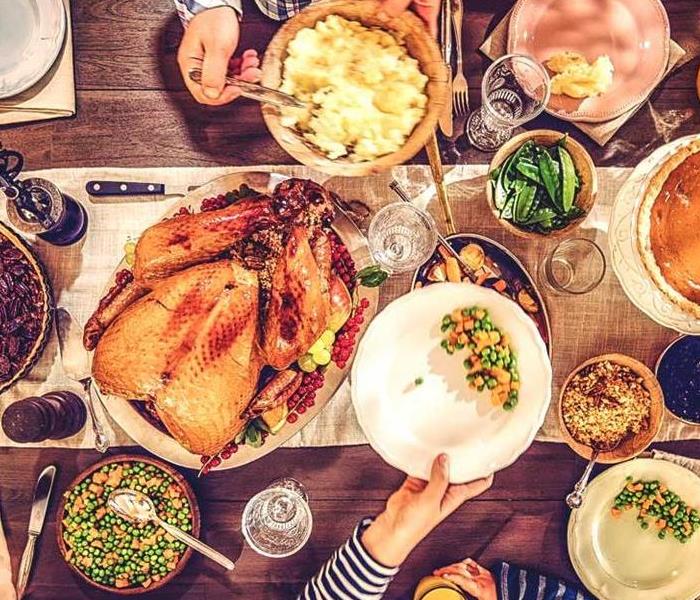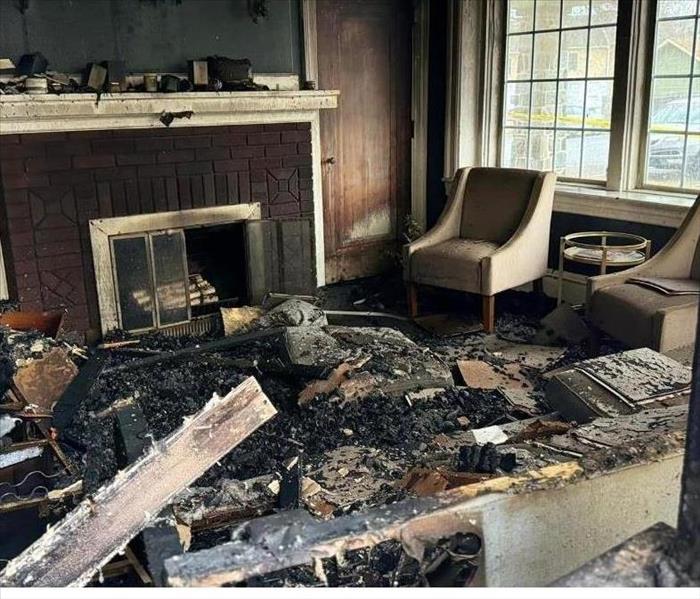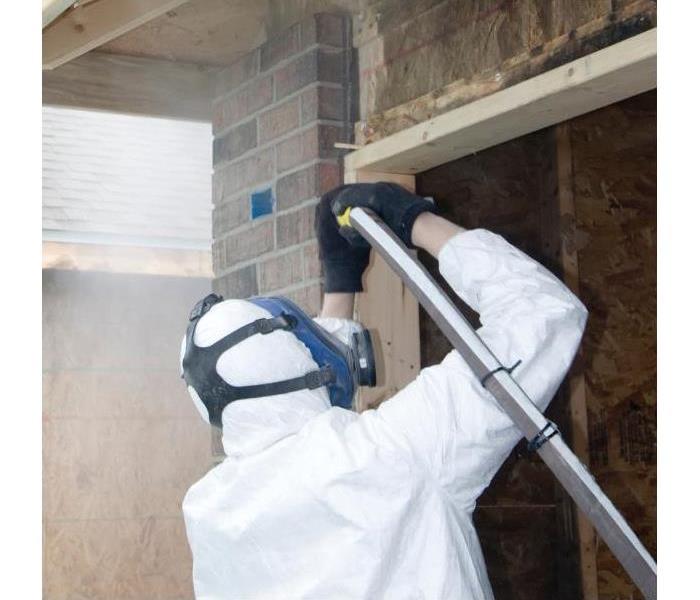Recent Fire Damage Posts
Furnace Fire in Lancaster
2/22/2024 (Permalink)
After the regulator in his propane furnace malfunctioned, this Lancaster homeowner suffered smoke and soot damage throughout the entire home. Our fire damage restoration professionals began the mitigation process immediately. The fire cleanup process is quite extensive. During this process, we often use our soot sponges to detect if there is soot in areas where it is less evident. This helps us to ensure that any signs of soot are eliminated from a property.
Once we have established which areas are affected, the removal process can begin! Our team thoroughly cleaned the structure from top to bottom, including surfaces such as the walls, ceilings and floors. At SERVPRO of Lancaster East and Southern Lancaster County, we get down to the details, removing the fire damage from the outlets and light fixtures, windows, doors and even the baseboards and trim.
Our odor deodorization techniques are then utilized to eliminate the airborne traces of smoke. Leaving a property with a clean and healthy environment is one of our top priorities when it comes to restoring a structure after fire damage. Content cleaning is also a critical component of the restoration process; we can restore damaged items, including even your salvageable documents and photos. SERVPRO of Lancaster East and Southern Lancaster County offers emergency assistance for fire damage in the Lancaster area while also providing the utmost care for your home and belongings!
Fire Destroys Leola Business!
12/28/2023 (Permalink)
SERVPRO of Lancaster East and Southern Lancaster County recently assisted a local salon that had been destroyed after a devastating fire. One of our local fire chiefs gave us a call to assist over the weekend, so we immediately went out to assess the fire damage and see what we could do to help!
Unfortunately, the building was too severely damaged to be saved, but we were able to help secure the property until demolition could begin. We provided temporary fencing as well as boarding up of the property.
When fire damage strikes, SERVPRO of Lancaster East and Southern Lancaster County assists our local homes and commercial properties based on each situation and its particular needs. Although it is always difficult to see a business or home destroyed by such a disaster, we are grateful to have the opportunity to help in any way possible. We strive to make these events less overwhelming for those involved!
SERVPRO of Lancaster East and Southern Lancaster County provides 24/7 emergency services for water and fire damage. Should you suffer any extent of property damage, give us a call so that we can begin the restoration process immediately!
Media Blasting
6/27/2023 (Permalink)
When significant fire damage occurs, SERVPRO of Lancaster East and Southern Lancaster County provides a range of advanced services to help restore what was lost. Often, the fire damage restoration process requires smoke and soot cleaning, content cleaning and removal, odor deodorization techniques and other professional services to make the damage to a property “Like it never even happened.” We also offer even more advanced techniques for when fire damage is too substantial to be removed with our routine methods.
One of these techniques is called media blasting, which helps to remove fragments of fire, smoke and soot damage from a structure. Media blasting involves using high pressure to force an abrasive material onto a surface to remove the damage on that surface. Baking soda, dry ice and garnet are a few of the materials that are often used to do this.
This technique has been shown to help remove difficult signs of fire damage from many surfaces so that we can restore any size property to preloss conditions. SERVPRO of Lancaster East and Southern Lancaster County uses media blasting when necessary in order to efficiently remove all signs of fire damage from a property. Our specialized fire damage restoration procedures allow our team to provide the utmost service for your home or business when disaster strikes!
Keep Your Kitchen Fire- Free!
7/8/2022 (Permalink)
 A significant kitchen fire we were called to.
A significant kitchen fire we were called to.
Although we love to serve our community, we always want you to take the proper precautions so you don't put yourself, business, or family in harm's way. Here are some helpful tips to prevent a fire in your kitchen- easily the most popular place fires occur.
Never leave a stove or oven unattended while you are cooking. Ensure your cooking surfaces are free from any flammable objects like paper towel, paper plates, or tea towels. It is best to clean your oven and stove regularly to make sure there isn't an excess of leftover food particles that may ignite during baking or grilling. Fire restoration in a kitchen can not only be very expensive but can have deadly consequences on the residents of the household.
Outlet Safety
7/8/2022 (Permalink)
 An electrical fire we serviced.
An electrical fire we serviced.
Besides kitchen fires, outlets are another easy fire starter. Here are some tips and tricks to help you avoid a disaster.
When you are shopping for a new light switch or power outlet, make sure you look for marks of certification on the packaging such as CSA, cUL or cETL. Electric devices like hairdryers and kettles will also come with certification marks. It is best to buy certified electrical products because this means they have met national safety standards and are less likely to break down or cause an electrical fire in your home. When you are using outlets, regularly inspect your cords and power cords like laptop cords, cellphone chargers and earphone cords. These are heavily used cords and often get bent, tied up, and stuffed into bags, purses and vehicles which further promotes wear and tear and deterioration of the protective wire coatings. The wires in your chargers should be completely covered at all times and invisible. Outlet safety is key to avoid electrical house fires and the need for fire restoration services.
What's Happening in February?
2/17/2022 (Permalink)
 It is important to take these safety measures to try and prevent burns and electrical fires.
It is important to take these safety measures to try and prevent burns and electrical fires.
Burn Awareness Week, observed the first full week in February (Feb 7th-13th), is a window of opportunity for organizations to mobilize burn, fire, and life safety educators to unite in sharing a common burn burn awareness and prevention message in our communities. The 2021 theme is Electrical Safety from Amps to Zap (A to Z)!
A is for Appliances: Plug major appliances directly into a wall outlet. DO not use extension cords or power strips. Only one-heating production appliance should be plugged into an outlet.
B is for Batteries: Batteries can short circuit when positive (+) and negative (-) terminals of a battery are in contact with each other. Batteries in a pocket with coins, keys, or other metal objects can short circuit and cause burns.
C is for Check Cords: Always check cords before use for cracks or frayed sockets, lose o bare wire, and loose connections.
For more burn prevention tips, visit ameriburn.org. If your home or business suffers from fire damage, contact us at 717-519-0767.
Kitchen Cautions
11/4/2021 (Permalink)
 Be sure to keep decorations away from open flames and heat sources, including light bulbs and heaters.
Be sure to keep decorations away from open flames and heat sources, including light bulbs and heaters.
Each year, around the holidays, families gather together to celebrate by preparing a delicious feast. However, not everyone practices safe cooking habits.
According to the National Fire Protection Agency, cooking fires are are the number one cause of home fires and injuries. The leading cause of fires in the kitchen is unattended cooking. It's important to be alert to prevent holiday cooking fires.
- Be on alert! If you are sleepy or have consumed alcohol, do not use the stovetop or oven.
- Stay in the kitchen while you are frying, grilling, boiling, or broiling food.
- If you are simmering, baking, or roasting food, check it regularly, remain in the kitchen while the food is cooking, and use a trimer to remind you that you are cooking.
- Keep anything that can catch fire, like oven mitts, wooden utensils, food packaging, or hand towels, away from the stovetop.
If you have a cooking fire, consider the following safety protocols to help keep you and your family safe.
- Just get out! When you leave, close the door behind you to help contain the flames.
- Call 9-1-1 or the local emergency number after you get out safely.
- For an oven fire, turn off the heat and keep the oven door closed.
- If you try to fight the fire, be sure others are getting out and you have a clear path out.
- Keep a lid nearby when you're cooking to smother small grease fires. Smother the fire by sliding the kid over the pan and turn off the stovetop. Leave the pan covered until it is completely cooled.
SERVPRO of Lancaster East wishes you a safe & happy fall season!
Serve Up Fire Safety in the Kitchen
11/4/2021 (Permalink)
 Visit firepreventionweek.org for more information on fire safety.
Visit firepreventionweek.org for more information on fire safety.
October is Fire Prevention Month and an excellent time to examine the emergency preparedness plans for your home and business, including your fire escape plan. Do you have a fire escape plan? Have you changed your smoke alarm batteries within the last year? Are you prepared for whatever happens?
The National Fire Protection Association (NFPA) sets aside a designated week each October to focus on fire prevention. Fire Prevention Week is October 4-10, 2020. The 2020 theme is, "Serve Up Fire Safety in the Kitchen!" This topic works to educate everyone about the simple but important actions they can take to keep themselves, and those around them, safe in the kitchen.
Did you know? Cooking is the number one cause of home fires and home fire injuries, according to NFPA. Unattended cooking is the leading cause of fire in the kitchen. NFPA notes that once a fire alarm goes off "you could have less than two minutes to get out safety," yet only 8 percent of people surveyed said getting out was the fire thought they had after hearing a fire alarm fire go off. Creating, implementing, and practicing a fire escape plan for your home or business may be the difference between safety and tragedy. Make a plan today!
As the #1 choice in cleanup and restoration, we stand on over 50 years of experience and expertise to help ensure you stay safe, informed, and ready for any disaster that comes your way. The time to prepare is now. Make sure your home and business are "Ready for whatever happens."
What To Do Until Help Arrives
11/4/2021 (Permalink)
 It is important to take preventative safety measures to prevent fires.
It is important to take preventative safety measures to prevent fires.
A fire can leave behind soot, smoke damage and a host of other problems. Ceilings, walls, woodwork, carpeting and floors will often need a thorough professional cleaning. If your home or business suffers a fire, it is important to take the appropriate steps to prevent further damage until the professionals at SERVPRO of Southern Lancaster County arrive.
DO:
- Limit movement in the home to prevent soot particles from being embedded into upholstery and carpet.
- Keeps hands clean. Soot on hands can further soil upholstery, walls and woodwork.
Place dry, colorfast towels or old linens on rugs, upholstery and carpet traffic areas. - If electricity is off, empty freezer/refrigerator completely and prop doors open to help prevent odor.
- Wipe soot from chrome kitchen/bathroom faucets, trim and appliances, then protect these surfaces with a light coating of lubricant.
- If heat is off during winter, pour RV antifreeze in sinks, toilet bowls, holding tanks and tubs to avoid freezing pipes and fixtures.
- Change HVAC filters; leave system off until a trained professional can check the system.
- Tape double layers of cheesecloth over air registers to stop particles of soot from getting in or out of the HVAC system.
DON'T:
- Don't attempt to wash the walls or painted surfaces without first contacting the professionals at SERVPRO of Southern Lancaster County arrive.
- Don't attempt to shampoo carpet or upholstered furniture without first consulting the professionals SERVPRO of Southern Lancaster County arrive.
- Do not attempt to clean any electrical appliances (TV sets, radios, etc.) that may have been close to fire, heat or water without first heat or water without first consulting an authorized repair service.
- Do not consume any food or beverages that may have been stored close to fire, heat, or water, as they may be contaminated.
- If ceiling is wet, do not turn on ceiling fans. Wiring may be wet or damaged and cause electrical shock, and air movement may create secondary damage.
- Don't send garments to the dry cleaner. Improper cleaning may set in smoke odor.
Cooking Can Cause A Fire In Your Home
10/27/2020 (Permalink)
 Never leave cooking food unattended.
Never leave cooking food unattended.
Did you know cooking equipment is the leading cause of residential fires? As the holiday season begins and you find yourself in the kitchen more often while hosting friends and family, fire precaution should be top of mind.
A property owner experiences a flood of emotions when a fire ravages their business or home. Fear, uncertainty, stress, and doubt about the future of their property and their livelihood can be overwhelming to the property owner long after the flames have been extinguished and the smoke has cleared. After the first wave of heroes have rescued the property, let the crew at SERVPRO of Southern Lancaster County help you restore it to its preloss condition. Combining rapid response, the utmost professionalism, and open communication throughout the entire job process, we strive to restore not only the home or business structure, but the customer's peace of mind as well.
The National Fire Protection Association (NFPA) offers the following eye-opening statistics on structure fires: more than one-quarter (27%) of reported fires occurred in homes within the last year. Even worse, 79% of fire-related deaths were caused by home fires. On average, U.S. fire departments respond to an estimated average of 354,400 home structure fires per year resulting in $6.9 billion in direct property damage. Most home fires and fire causalities result from five causes; cooking, heating, electrical distribution and lighting equipment, intentional fire setting, and smoking materials.
If the unthinkable happens and a fire strikes your home or business, give the experts at SERVPRO of Southern Lancaster County a call. We will help to make it "Like it never even happened."
Emergency Fire Damage Tips
9/23/2020 (Permalink)
 Portable fire extinguishers can be life and property saving tools when used correctly.
Portable fire extinguishers can be life and property saving tools when used correctly.
There emergency tips will assist you in taking proper action until the SERVPRO professionals arrive. Follow these DOs and DON'Ts to help reduce damage and increase the chances of a successful restoration.
DO:
- Limit movement in the home to prevent soot particles from being embedded into carpet and avoid tracking.
- Keep your hands clean. Soot on your hands can further soil upholstery, walls, and woodworking.
- If electricity is off, empty the freezer and refrigerator completely and prop doors open to help prevent odor.
- Wipe soot form metal kitchen and bathroom faucets, trim, and appliances.
- If heat is off during winter months, pour RV antifreeze in sinks, toilet bowls, and holding tanks, and tubs to avoid freezing pipes and fixtures.
- Remove soot particles from plants with a damp cloth.
- Change HVAC filter, but leave it off until a trained professional can check the system.
- Tape double layers of cheesecloth over air registers to stop particles of soot from getting in our our of the HVAC system.
DON'T:
Don't attempt to wash any walls or painted surfaces without first contacting SERVPRO of Southern Lancaster County.
Don't attempt to shampoo carpet, rugs, or upholstered furniture without first consulting SERVPRO of Southern Lancaster County.
Don't attempt to clean any electrical appliances (TV sets, radios, etc.) that may have been closet to fire, heat, or water without first consulting an authorized repair service.
Don't consume any food or beverages that may have been stored close to fire, heat, or water. (They may be contaminated.)
Don't turn on ceiling fixtures if ceiling is wet. Wiring may be wet or damaged and cause electrical shock and air movement may create secondary damage.
Don't send garments to the dry cleaner. Improper cleaning may set in smoke odor.
Smoke Alarms Are Life Savers
9/1/2020 (Permalink)
 Did you know? 7 people die every day from a home fire.
Did you know? 7 people die every day from a home fire.
Smoke alarms save lives when properly installed and maintained, according to the National Fire Protection Association (NFPA).
In homes, smoke alarms should be in every bedroom and on every level, including the basement. In office and commercial environments, check your state environments or contact your local Fire Marshall to help ensure all codes are met.
Test smoke alarms monthly using the test button. Smoke alarms with non-replaceable batteries need the entire smoke alarm unit replaced every ten years. Other alarms need batteries replaced every year and the unit or the batteries immediately. Never disable or remove the battery from an alarm. Almost half of the fires where smoke alarms had missing or disconnected batteries (NFPA).
In larger commercial facilities, hard wire or wireless smoke alarms offer benefits such as not needing to be tested as often and activating throughout the entire building if smoke is detected in just one area (NFPA).
If you need help installing, testing or changing batteries in your smoke alarms, contact your local fire department, an electrician, or the American Red Cross.
Be sure your home or workplace has a fire emergency plan in place and conduct regular fire drills. For more information on Emergency Preparedness, contact your local professionals at SERVPRO of Southern Lancaster County.
Always Take Fire Safety Precautions
11/18/2019 (Permalink)
 Be sure to take safety measures this holiday season!
Be sure to take safety measures this holiday season!
Did you know cooking equipment is the leading cause of residential fires? As the holiday season begins and you find yourself in the kitchen more often while hosting friends and family, fire precautions should be top of mind.
A property owner experiences a flood of emotions when a fire ravages their business or home. Fear, uncertainty, stress, and doubt about the future of the property and their livelihood can be overwhelming to the property owner long after the flames have been extinguished and the smoke has cleared.
After the first wave of heroes have rescued the property, let your professionals at SERVPRO of Lancaster East help you restore it to its preloss condition. Combining rapid response, the utmost professionalism, and open communication throughout the entire job process, we strive to restore not only the home or business structure, but the customer's peace of mind as well.
The National Fire Protection Association (NFPA) offers the following eye-opening statistics on structure fires.
- 482,030 structure fires were reported in the United States in 2018.
- These fires caused $9.9 billion in property damages.
- One structure fire was reported every 48 seconds.
If the unthinkable happens and a fire strikes your business or home, give your experts here at SERVPRO of Lancaster East a call. We will help make it "Like it never even happened."
When They Call You, Call SERVPRO
10/1/2019 (Permalink)
 Contact us to help you get back into a clean home!
Contact us to help you get back into a clean home!
Mitigation requires quick action. The faster SERVPRO professionals arrive on-site to perform fire, smoke, and soot cleanup and restoration, the better the results- including lower claim costs. Within four hours of a loss notification, a SERVPRO professional will be on-site to help ensure a fire damage is handled properly by utilizing the following services.
Structural Cleaning
After a smoke or fire damage, ceilings, walls, woodwork, carpeting, and floors will often need a thorough cleaning. Your experienced local SERVPRO professionals will pretest to determine the extent of damage, then use the specific equipment and cleaning products required to clean and protect the different types of surfaces found within the structure.
Contents Cleaning
All of the restorable contents in the affected areas will be professionally cleaned and deodorized. This included area rugs, furniture, draperies, and upholstery. SERVPRO of Lancaster East can provide wet or dry cleaning services. Additionally, all of the other restorable contents will be cleaned and deodorized to preloss condition. This includes electronics, art, wood furniture, kitchen items, clothing, bedding, and much more. Finally, SERVPRO professionals can provide an inventory list of all "to be claimed" items for agents and their policyholders.
Deodorization
SERVPRO of Lancaster East provides specialized services that rid your insured's home or place of business of offensive odors left behind by fire or smoke damage. SERVPRO professionals do not merely cover up lingering odors with a fragrance; they seek out the sources of the odor and remove them.
Smoke Alarms: Life Savers
1/31/2019 (Permalink)
 $7 Billion in property damage from fire losses occurs every year
$7 Billion in property damage from fire losses occurs every year
Smoke alarms save lives when properly installed and maintained, according to the National Fire Protection Association (NFPA).
In homes, smoke alarms should be in every bedroom and on every level, including the basement. In office and commercial environments, check your state requirements or contact your local Fire Marshall to help ensure all codes are met.
Test smoke alarms monthly using the test button. Smoke alarms with non-replaceable batteries need the entire smoke alarm unit replaced every ten years. Other alarms need batteries replaced every year and the unit replaced every ten years. If the alarm chirps signaling low battery, take the proper steps to replace the unit or the batteries immediately. Never disable or remove the battery from an alarm. Almost half of fires where smoke alarms were present but did not activate had missing or disconnected batteries.
In larger commercial facilities, hard wired or wireless smoke alarms offer benefits such as not needing to be tested as often and activating throughout the entire building if smoke is detected in just one area (NFPA).
If you need help installing, testing, or changing batteries in your smoke alarms, contact your local fire department, and electrician, or the American Red Cross.
Be sure your home or workplace has a fire emergency plan in place and conduct regular fire frills. For more information on Emergency Preparedness, contact SERVPRO of Lancaster East at 717-519-0767.
Celebrate Safety This Holiday Season
11/30/2018 (Permalink)
 Christmas Eve and Christmas Day are two of the top days for home candle fires.
Christmas Eve and Christmas Day are two of the top days for home candle fires.
Pretty lights, candles and decorations are just a few of the items bringing charm and cheer to the holiday season- however, if they are not used carefully your holidays may go from festive to frightening.
The American Red Cross offers the following safety tips to help greatly reduce the fire risk in your home or businesses this holiday season.
- Place Christmas trees, candles and other holiday decorations at least three feet away from heat sources like fireplaces, portable heaters, radiators, heat vents and candles.
- Make sure light strings and other holiday are in good condition. Do not use anything with frayed electrical cords and always follow the manufacturer's instructions.
- Always unplug tree and holiday lights before leaving the property or going to bed.
- Never use lit candles to decorate a tree. Always extinguish candles before leaving the room or going to bed.
- Use only sturdy tree stands designed not to tip over. Keep curious pets and children away from Christmas trees.
- Keep anything that can catch fire- pot holders, over mitts, wooden utensils, paper of plastic bags, food packaging and towels or curtains- away from your stove top.
- Designate one person to walk around your property to ensure all candles and smoking materials are properly extinguished after guests leave.
SERVPRO of Lancaster East wishes you a safe and happy holiday season!
Safety First Before the Feast
11/1/2018 (Permalink)
 Happy Thanksgiving to you and your family!
Happy Thanksgiving to you and your family!
Each November, families gather to celebrate Thanksgiving by preparing a delicious feast, but if you don't practice safe cooking habits, your happy holiday could become hazardous very quickly.
According to the National Fire Protection Association, cooking is the main cause for home fires and injuries, with Thanksgiving being the peak day for cooking-related fires.
Review the following safety tips to help ensure you can enjoy a safe holiday.
- Never leave cooking food unattended-stay in the kitchen when frying, grilling or broiling food. If someone must leave the kitchen for even a short period of time, they should turn off the stove.
- Check food regularly while cooking and remain in the home while cooking.
- Keep the kids away from the cooking area. Enforce a "kid-free zone" and make them stay at least three feet away from the stove.
- Keep anything flammable-pot holders, oven mitts, wooden utensils, paper or plastic bags, food packaging and towels or curtains-away from the stove, over or any other appliance in the kitchen that generates heat.
- Do not wear loose clothing or dangling sleeves while cooking.
- Clean cooking surfaces on a regular basis to prevent grease buildup.
- Purchase a fire extinguisher to keep in the kitchen. Contact the local fire department for training on the proper use of extinguishers.
- Always check the kitchen before going to bed or leaving the home to make sure all stoves, ovens, and small appliances are turned off.
- Install a smoke alarm near the kitchen, on each level of the home, near sleeping areas and inside and outside bedrooms. Use the test button to check it each month. Replace all batteries at least once a year.
Your local professionals at SERVPRO of Southern Lancaster County wish you a safe and happy holiday season.
Fires are Preventable!
10/1/2018 (Permalink)
 Prepare your home with fire safety precautions
Prepare your home with fire safety precautions
When it comes to you or your insured's properties, there are certain safety precautions that can be taken to help prevent fires. Ready.gov shares the following tips on home fire prevention.
Electrical and Appliance Safety
- Frayed wires can cause fires. Replace all worn, old, or damaged appliance cords immediately and do not run cords under rugs or furniture.
- If an appliance has a three-prong plug, use it only in a three-slot outlet. Never force it to fit into a two-slot outlet or extension cord.
- Immediately shut off, then professionally replace, light switches that are hot to the touch and lights that flicker.
Fireplaces and Woodstoves
- Inspect and clean woodstove pipes and chimneys annually and check monthly for damage and obstructions.
- Use a fireplace screen heavy enough to stop rolling logs and big enough to cover the entire opening of the fireplace to catch flying sparks
- Make sure the fire is completely out before leaving the house or going to bed.
Fire Safety
11/23/2016 (Permalink)
 House Fire
House Fire
Looking for a Great Holiday Gift Idea? Give Your Family a Fire Safety Plan
Local SERVPRO® restoration specialist highlights the difference between fire prevention planning and fire safety planning
The holidays are approaching and many families are finalizing plans for elaborate meals, get-togethers with friends, and decorating with festive lights. Amidst all this planning, Joseph Barrett of SERVPRO® of Lancaster East reminds homeowners that they may be overlooking the most important plan they can make—a fire safety plan.
Statistics
“Each year, statistics1 show the incidence of home cooking and candle fires peaks during the holiday season. This tends to focus homeowners on fire prevention precautions—and that’s a good thing,” said Barrett. “But to truly protect your family from the dangers of a home fire, at the holidays and throughout the year, you need to start with a fire safety plan. Developing a fire safety plan and practicing it regularly with your family is the most important step you can take to help prevent a house fire from turning into a devastating tragedy.”
SERVPRO is a national leader and provider of fire and water cleanup and restoration services, and their disaster response professionals know from experience how devastating a home fire can be. They also know that when fire causes a loss of life, there is no “remediation” possible. This is why SERVPRO has teamed up with the American Red Cross (ARC) by supporting the ARC Disaster Responder2 program, and in particular the Home Fire Preparedness Campaign3. As a Disaster Responder, SERVPRO pledges dollars and support in advance to help the ARC develop and distribute educational materials and respond immediately when they are needed.
Barrett encourages all Willow Street-area homeowners to follow these fire safety guidelines, developed by the ARC through their Home Fire Preparedness Campaign, to help minimize injury or loss of life due to a residential fire.
- Install the right number of smoke alarms4. Test them once a month and replace the batteries at least once a year.
- Teach children what smoke alarms sound like5 and what to do when they hear one.
- Ensure that all household members know two ways to escape6 from every room of your home and know the family meeting spot outside of your home.
- Establish a family emergency communications plan and ensure all household members know who to contact if they cannot find one another.
- Practice escaping from your home at least twice a year. Press the smoke alarm test button or yell “Fire” to alert everyone they must get out.
- Make sure everyone knows how to call 9-1-1.
- Teach household members to STOP, DROP and ROLL if their clothes should catch on fire.
“Fire prevention and fire safety planning are two very different things,” said Barrett. “Fire prevention planning helps control or eliminate the causes of a fire. Fire safety planning helps prevent injury and loss of life when a fire does break out. To protect your family and your property, you need both.”
For more fire prevention and fire safety tips and information about fire and water damage restoration services, please visit www.SERVPRO.com. For more information on SERVPRO® of Lancaster East, please contact Joseph Barrett at (717) 519-0767 or SERVPRO8837@comcast.net.
Smoke and Soot Cleanup
9/19/2016 (Permalink)
Smoke and soot is very invasive and can penetrate various cavities within your home, causing hidden damage and odor. Our smoke damage expertise and experience allows us to inspect and accurately assess the extent of the damage to develop a comprehensive plan of action.
Smoke and soot facts:
- Hot smoke migrates to cooler areas and upper levels of a structure.
- Smoke flows around plumbing systems, seeping through the holes used by pipes to go from floor to floor.
- The type of smoke may greatly affect the restoration process.
Different Types of Smoke
There are two different types of smoke–wet and dry. As a result, there are different types of soot residue after a fire. Before restoration begins, SERVPRO of Lancaster East will test the soot to determine which type of smoke damage occurred. The cleaning procedures will then be based on the information identified during pretesting. Here is some additional information:
Wet Smoke – Plastic and Rubber
- Low heat, smoldering, pungent odor, sticky, smeary. Smoke webs are more difficult to clean.
Dry Smoke – Paper and Wood
- Fast burning, high temperatures, heat rises therefore smoke rises.
Protein Fire Residue – Produced by evaporation of material rather than from a fire
- Virtually invisible, discolors paints and varnishes, extreme pungent odor.
Our Fire Damage Restoration Services
Since each smoke and fire damage situation is a little different, each one requires a unique solution tailored for the specific conditions. We have the equipment, expertise, and experience to restore your fire and smoke damage. We will also treat your family with empathy and respect and your property with care.
Have Questions about Fire, Smoke, or Soot Damage?
Call Us Today – 717-519-0767

 24/7 Emergency Service
24/7 Emergency Service


















